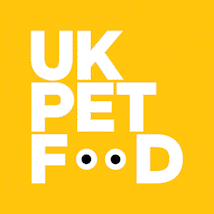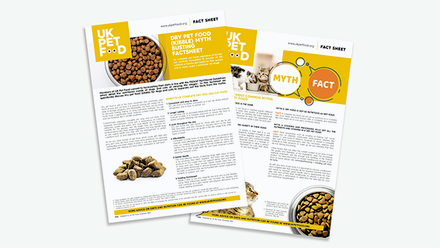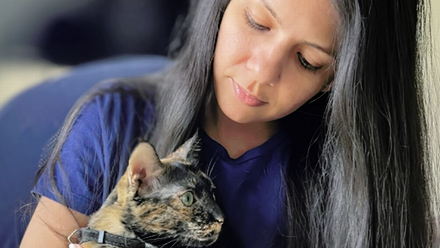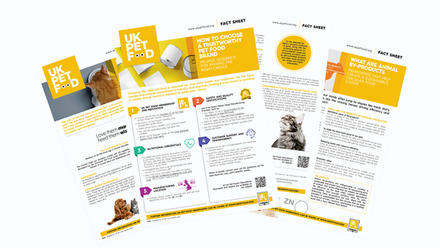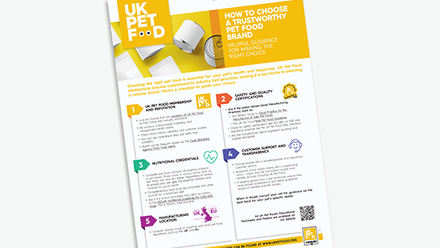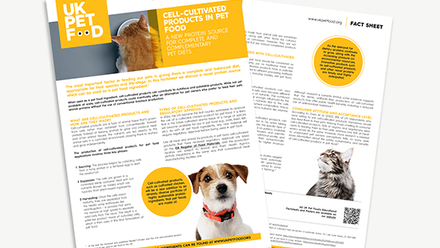Grain Free Pet Foods for Cats and Dogs.pdf
What are grains?
Grains are a group of ingredients that contain carbohydrates and are used in pet foods, including rice, wheat, barley, sorghum, maize (corn), etc.
Does grain-free mean carbohydrate-free?
Not necessarily. Carbohydrates are also present in other ingredients, like potatoes and sweet potatoes.
Are grain-free pet foods healthier?
The most important consideration when deciding what diet to feed is whether it provides complete and balanced nutrition. If there is too much of one nutrient and not enough of others, it will impact the pet’s health. This principle is true regardless of whether the pet food contains grain or not.
The nutrient profile of a product is more important than any one ingredient. The best way to ensure a healthy diet is to feed a complete pet food appropriate to the pet type and their life stage.
After that, it comes down to consumer choice. For those who prefer grain-free pet food – there is a good selection of products on the market.
Normal healthy cats and dogs have no dietary need for carbohydrates, so why are they used in pet foods?
Whilst cats and dogs have no absolute dietary need for carbohydrates, they can play an important and beneficial role in their diet. Carbohydrates in pet food provide a useful and readily available source of metabolisable energy and fibre. By using carbohydrates instead of fat or protein to obtain energy, these other nutrients can be used to optimise healthy skin, coat, immune systems etc.
The classification of carbohydrates also includes dietary fibre. Certain fibres, for example, moderately fermentable fibres (e.g. beet pulp or rice bran), can also have a beneficial effect on the health of the digestive tract. The carbohydrate levels found in prepared pet foods are well tolerated by the vast majority of dogs and cats.
Grain-free pet foods have recently become popular, and they link to the concept of the ancestral diet, the diet a non-domesticated dog or cat would have eaten in the wild. Feeding a high-protein diet is very appealing to some owners, and it can still be achieved in diets that contain some grains.
Are grain-free diets better for pets with allergies?
There is an assumption that grain-free diets are the best diets for pets with food allergies. While food allergies occur in pets, the incidence of true dietary intolerance or allergies in pets is rare. On the whole, the prevalence of all food allergies in the dog and cat population is thought to be around 0.1%.
Whilst a very small number of pets, like humans, may be intolerant or allergic to a particular grain, this does not mean that all animals will be affected or that any one grain is inherently bad.
Available research has highlighted that the most common proven allergens for cats and dogs include beef, chicken and dairy products. In one literature review, 278 dogs with food allergies were evaluated, and the problem ingredient was clearly identified for each dog. Beef was the most common allergen, being responsible for 95 of the cases reported. Dairy was responsible for 55 cases, making it the second most frequent cause. Corn was identified as the offender in only 7 cases. In cats, the situation is similar. Fifty-six cats were evaluated in this study. Forty-five of the food allergies resulted from eating beef, dairy, and/or fish. Corn, meanwhile, was responsible for only 4 cases. Owners concerned about dietary intolerances or allergies should speak to their vet.
Pet Food Nutritional Guidelines
All pet foods labelled as ‘complete’ must contain all the nutrients a pet needs in the right balance for healthy bodily function – this is a requirement set down in legislation.
Members of the UK Pet Food produce their diets in line with the FEDIAF Nutritional Guidelines, which detail the nutritional needs of pets at different life stages and are peer-reviewed by veterinary experts throughout Europe.
Further Reading
- Carlotti DN, Remy I, Prost C. Food allergy in dogs and cats. A review and report of 43 cases. Vet Dermatol 1990; 1:55-62.
- Chesney CJ. Food sensitivity in the dog: a quantitative study. J Sm Anim Pract 2002;43:203-207.
- Elwood CM, Rutgers HC, Batt RM. Gastroscopic food sensitivity testing in 17 dogs. J Sm Anim Pract 1994;35:199-203.
- Harvey RG. Food allergy and dietary intolerance in dogs: a report of 25 cases. J Sm Anim Pract 1993;34:175-179.
- Ishida R, Masuda K, Sakaguchi M, et al. Antigen-specific histamine release in dogs with food hypersensitivity. J Vet Med Sci 2003; 65:435-438.
- Ishida R, Masuda K, Kurata K, et al. Lymphocyte blastogenic responses to inciting food allergens in dogs with food hypersensitivity. J Vet Intern Med 2004; 18:25-30.
- Jeffers JG, Shanley KJ, Meyer EK. Diagnostic testing of dogs for food hypersensitivity. J Am Vet Med Assoc 1991; 189:245-250.
- Jeffers JG, Meyer EK, Sosis EJ. Responses of dogs with food allergies to single-ingredient dietary provocation. J Am Vet Med Assoc 1996;209:608-611.
- Kunkle G, Horner S. Validity of skin testing for diagnosis of food allergy in dogs. J Am Vet Med Assoc 1992; 200:677-680.
- Mueller RS, Tsohalis J. Evaluation of serum allergen-specific IgE for the diagnosis of food adverse reactions in the dog. Vet
- Dermatol 1998; 9:167-171.
- Mueller RS, Friend S, Shipstone MA, et al. Diagnosis of canine claw disease – a prospective study of 24 dogs. Vet Dermatol 2000; 11:133-141.
- Nichols PR, Morris DO, Beale KM. A retrospective study of canine and feline cutaneous vasculitis. Vet Dermatol 2001; 12:255-264.
- Paterson S. Food hypersensitivity in 20 dogs with skin and gastrointestinal signs. J Sm Anim Pract 1995; 36:529-534.
- Tapp T, Griffin C, Rosenkrantz W, et al. Comparison of a commercial limited-antigen diet versus home-prepared diets in the diagnosis of canine adverse food reactions. Vet Therapeutics 2002; 3:244-251.
